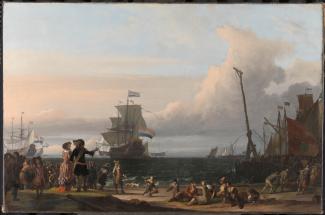The Verenigde Oostindische Compagnie (VOC), commonly known as the Dutch East India Company, has been described as the world’s first multinational company. The VOC’s trade reached across the Indian Ocean and stretched as far as Japan and China. The wealth this trade brought back to the Netherlands created what was termed ‘a golden age’ of prosperity for this small, newly independent country.
First expedition
The first Dutch expedition to the East Indies was organised by a consortium of nine Amsterdam businessmen. Armed with weapons supplied free of charge by the Dutch government who were anxious to see the venture succeed, four ships set sail in 1595. Three years later, the ships returned with pepper, nutmeg and mace, and the venture itself yielding a profit. By 1601, fourteen fleets had travelled to the East Indies, with profits of more than 400% made by some of the more successful expeditions. The Dutch were also discovering that, as Portugal had only limited naval strength in this region, they could offer improved trading terms or simply use their superior force with Asian kings and potentates.
The world’s first multinational
The greatest problem facing the Dutch was their own success. By 1601 the different East Indian companies formed by investors from different towns or regions in the Netherlands were beginning to compete seriously with each other and drive up prices. In 1602 a very original commercial institution was formed after lengthy negotiations by the Dutch Republic's central government: the Verenigde Oostindische Compagnie (VOC). Cities or provinces, which had sent out East Indian expeditions were granted a chamber or branch establishment amounting to six chambers in total. The VOC was given extraordinary independence from the Dutch federal government. It had a complete monopoly in the Far East and no independent Dutch merchants were allowed to operate there. The VOC had the right to set its own trade policies, conduct its own negotiations with foreign rulers, acquire and govern land in Asia, build its own fortified bases, raise its own military forces and wage wars. Control of the VOC was given to a board called Heeren XVII or Gentlemen Seventeen who were representatives of the different chambers. While the city of Amsterdam was the greatest contributor to the VOC, concern from other cities that it would become too powerful, meant it received only eight of 17 places on the board, giving other chambers the majority.
Expelling the Portuguese
In 1604, the VOC sent out a heavily armed fleet of 13 merchantmen to conquer Portuguese-held spice islands in the Moluccas, establish bases, and secure most of the world's trade in nutmeg, mace, and cloves. The new, powerful and extremely-well financed VOC quickly became the dominant force in the Far East. The VOC’s policy was neatly summed up by one company officer who went on to become the Governor-General in the Far East:
‘…we cannot carry trade without war nor war without trade.’
Governor-General Jan Pieterszoon Coen, the VOC's de facto chief executive [in the East Indies], to the Heeren XVII, the VOC's board of directors [in the Dutch Republic] (1614)
A bloody legacy
The VOC was responsible for a series of massacres of Indigenous peoples of the East Indies, under the direction of the Heeren XVII and led by Coen - particularly in Banda (1621) and Ambon (1623). Breaches of the nutmeg and mace trade monopoly were used as the excuse to massacre and displace most of the population. The VOC also took part in slavery and slave trading during its two hundred years of activity, taking people from East Africa, Madagascar and the Mascarene Islands (Mauritius and Réunion), the Indian subcontinent and southeast Asia. Laurens Real, the Governor-General in the East Indies (1615-1619), introduced slave labour into the nutmeg plantations on Ambon while his successor, Coen, introduced slave labour to the rest of the VOC settlements in the East Indies. By the time Jan van Riebeeck settled in the Cape in 1652, slavery was a long-established way of obtaining labour for the VOC.
Expansion and decline
The VOC rapidly expanded and constructed a maritime empire. Controlling coastal areas like the Cape in Southern Africa and avoiding unrest inland was necessary for uninterrupted trade. Eventually, the VOC were able to control the Spice Islands with the exception of a few British outposts. Unlike other trading companies, the VOC set up an intra-Asiatic trade network. Although it was unsuccessful in fully eliminating its competition, the VOC was the only company permitted to trade with Japan. During its existence, the VOC imported more goods and sent more ships to Asia than all other European trade companies combined. It was declared bankrupt and nationalised in 1798 after decades of financial problems, partially due to the wars with England.
